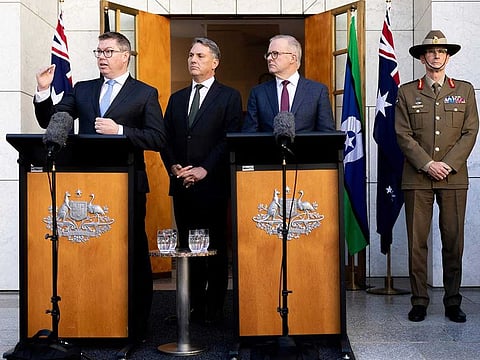Australia to prioritise long-range strike capability in defence shake-up
Northern bases to become focus for deterring adversaries and protecting trade routes

Canberra: Australia’s government will prioritise long-range precision strike capability, domestic production of guided weapons, and diplomacy - key points of a review released Monday recommending the country’s biggest defence shake-up since World War Two.
The review said the United States was no longer the “unipolar leader of the Indo Pacific”, that intense competition between the US and China was defining the region, and that the major power competition had “potential for conflict”.
The country’s northern bases will become a focal point for deterring adversaries, and protecting trade routes and communications, the review said.
Prime Minister Anthony Albanese called the review “the most significant work that’s been done since the Second World War”, and said his government would act on its recommendations.
“We must build the strength in our security by seeking to shape the future rather than waiting for the future to shape us,” he told reporters.
China is undertaking the largest military buildup of any country since the end of World War Two, which was occurring “without transparency or reassurance to the Indo-Pacific region of China’s strategic intent”, the review said.
China is also engaged in strategic competition in Australia’s near neighbourhood.
A public version of the classified report released on Monday said Australia must “avoid the highest level of strategic risk we now face as a nation: the prospect of major conflict in the region”.
The military threat to Australia does not require invasion in the “missile age”, it said.
Australia will work more closely with its major ally the United States, including increased bilateral military planning, joint patrols and hosting more rotations of US forces, including submarines, it said.
Australia must also strengthen defence cooperation with Japan, India, Pacific and South East Asian nations to maintain regional balance, the review said.
Australia must be able to defend its territories and the immediate region, deter any adversary’s attempt to project power through its northern approaches, and protect trade routes and communications, Defence Minister Richard Marles said in the government’s response to the review.
The review found Australia’s defence force was “not fit for purpose”, he said. “We aim to change the calculus so no potential aggressor can ever conclude that the benefits of conflict outweigh the risks.” The AUKUS nuclear-powered submarine programme is a priority for Australia’s deterrence capability, the review confirmed.
Long-range strike and guided weapons are also “fundamental to the Australian Defence Force’s ability to hold an adversary at risk”, the review said, adding that domestic production of these weapons would be established, and acquisition sped up.
In an interview with ABC TV on Monday evening, Marles said the Ukraine war had shown stockpiles of missiles among “friends and allies” is not where it needs to be, and why it is important to manufacture munitions in Australia.
“We will obviously be doing that very closely with the United States. We are working to be close enough to have an interchangeability of missiles between our two defence forces and that’s what will give rise to the maximising of Australian capability,” he said.
Australia will upgrade its northern bases and ports immediately, and the review said the country must rectify fuel storage issues. The government said it would explore using civil mineral and petroleum industry infrastructure in northern and central Australia.
Areas it said were critical included undersea warfare including drones for surveillance and strike; maritime operations for sea denial and local sea control; air and missile defence; and expeditionary theatre logistics.
Australia’s area of military interest spans the northeast Indian Ocean, through maritime Southeast Asia into the Pacific, the review said.
The navy needs more smaller vessels with long-range strike weapons, with details decided after an independent analysis this year, the report said.
The review recommends long-range anti-ship missiles for Australia’s F-35A and F/A-18F fighter jets, and the development of the Ghost Bat uncrewed aircraft with the United States.
Defence funding will increase over the next decade, but will stay steady over the next four years, with funding of A$19 billion for the review’s recommendations, including A$7.8 billion diverted from cancelled projects.
“The plan is strong and based on a realistic appraisal of the circumstances,” said John Blaxland, a professor of international security at Australian National University.
Australia forward-deployed its military in Southeast Asia and the Pacific islands during World War Two, he said, and the HIMARS rocket artillery and amphibious landing craft recommended by the review are “only feasible if used in a collaborative arrangement with Australia’s neighbours”.
“The neighbours aren’t in a position to guarantee any commitment because we are not allied with them. Security agreements with them are loosely worded and we need to respect their sovereignty,” he added.
Sign up for the Daily Briefing
Get the latest news and updates straight to your inbox



